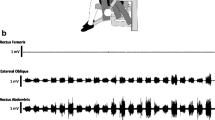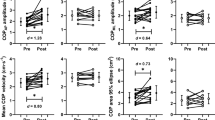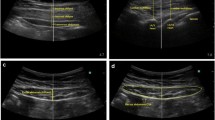Abstract
Purpose
Lateral trunk muscles may contribute to the excessive ipsilateral trunk lean, which is a mechanical alteration related to impairment in hip and knee kinematics. This study aimed to investigate if hip and knee kinematics, lateral abdominal muscle thickness, and trunk muscle endurance are associated differently in men and women.
Methods
Forty-six participants (27 men and 19 women) completed the following assessments: (1) lateral abdominal muscles thickness [external oblique + internal oblique + transversus abdominis] measured with ultrasound; (2) hip adduction (HADD) and knee frontal plane projection angle (FPPA) during single-leg squat; (3) muscle endurance in the side plank test.
Results
We did not find significant associations between HADD and lateral abdominal muscle thickness (men: r = 0.205; p = 0.315; women: r = 0.358; p = 0.145) or side plank time (men: rs = − 0.102; p = 0.614; women: rs = 0.391; p = 0.098). Moreover, no significant associations were found between FPPA and lateral abdominal muscle thickness (men: r = 0.012, p = 0.953; women: r = 0.326, p = 0.186) or side plank time (men: rs = 0.087, p = 0.667; women: rs = 0.319, p = 0.184). A strong association between lateral abdominal muscle thickness and muscle endurance was found only in women (r = 0.683; p = 0.002).
Conclusion
Hip and knee kinematics were not associated with lateral abdominal muscle structure or endurance in men and women. Muscle structure seems to be associated with time to exhaustion in a side plank test only in women.




Similar content being viewed by others
Availability of data and materials
Not applicable.
Code availability
Not applicable.
References
Powers CM, Witvrouw E, Davis IS, Crossley KM (2017) Evidence-based framework for a pathomechanical model of patellofemoral pain: 2017 patellofemoral pain consensus statement from the 4th International Patellofemoral Pain Research Retreat, Manchester, UK: part 3. Br J Sports Med 51:1713–1723
Burnham JM, Yonz MC, Robertson KE, McKinley R, Wilson BR, Johnson DL et al (2016) Relationship of hip and trunk muscle function with single leg step-down performance: implications for return to play screening and rehabilitation. Phys Ther Sport 22:66–73
Ireland ML, Willson JD, Ballantyne BT, Davis IM (2003) Hip strength in females with and without patellofemoral pain. J Orthop Sports Phys Ther 33:671–676
Mendiguchia J, Ford KR, Quatman CE, Alentorn-Geli E, Hewett TE (2011) Sex differences in proximal control of the knee joint. Sports Med 41:541–557
Northeast L, Gautrey CN, Bottoms L, Hughes G, Mitchell ACS, Greenhalgh A (2018) Full gait cycle analysis of lower limb and trunk kinematics and muscle activations during walking in participants with and without ankle instability. Gait Posture 64:114–118
Herrington L, Alenezi F, Alzhrani M, Alrayani H, Jones R (2017) The reliability and criterion validity of 2D video assessment of single leg squat and hop landing. J Electromyogr Kinesiol 34:80–85
Weltin E, Mornieux G, Gollhofer A (2015) Influence of gender on trunk and lower limb biomechanics during lateral movements. Res Sports Med 23:265–277
Nakagawa TH, Maciel CD, Serrao FV (2015) Trunk biomechanics and its association with hip and knee kinematics in patients with and without patellofemoral pain. Man Ther 20:189–193
Shirey M, Hurlbutt M, Johansen N, King GW, Wilkinson SG, Hoover DL (2012) The influence of core musculature engagement on hip and knee kinematics in women during a single leg squat. Int J Sports Phys Ther 7:1–12
Gardner-Morse MG, Stokes IA (1998) The effects of abdominal muscle coactivation on lumbar spine stability. Spine 23:86–91
Neumann DA (2013) Kinesiology of the musculoskeletal system-e-book: foundations for rehabilitation. Elsevier Health Sciences, New York
Stickler L, Finley M, Gulgin H (2015) Relationship between hip and core strength and frontal plane alignment during a single leg squat. Phys Ther Sport 16:66–71
Willson JD, Ireland ML, Davis I (2006) Core strength and lower extremity alignment during single leg squats. Med Sci Sports Exerc 38:945–952
Jamison ST, McNally MP, Schmitt LC, Chaudhari AM (2013) The effects of core muscle activation on dynamic trunk position and knee abduction moments: implications for ACL injury. J Biomech 46:2236–2241
Biabanimoghadam M, Motealleh A, Cowan SM (2016) Core muscle recruitment pattern during voluntary heel raises is different between patients with patellofemoral pain and healthy individuals. Knee 23:382–386
Zazulak BT, Hewett TE, Reeves NP, Goldberg B, Cholewicki J (2007) Deficits in neuromuscular control of the trunk predict knee injury risk: a prospective biomechanical-epidemiologic study. Am J Sports Med 35:1123–1130
Stock MS, Mota JA, Hernandez JM, Thompson BJ (2017) Echo intensity and muscle thickness as predictors of athleticism and isometric strength in middle-school boys. Muscle Nerve 55:685–692
Hewett TE, Myer GD, Ford KR, Paterno MV, Quatman CE (2016) Mechanisms, prediction, and prevention of ACL injuries: Cut risk with three sharpened and validated tools. J Orthop Res 34:1843–1855
Cronström A, Creaby MW, Nae J, Ageberg E (2016) Gender differences in knee abduction during weight-bearing activities: a systematic review and meta-analysis. Gait Posture 49:315–328
Schmitz A, Russo K, Edwards L, Noehren B (2014) Do novice runners have weak hips and bad running form? Gait Posture 40:82–86
Jeong J, Choi DH, Shin CS (2021) Core strength training can alter neuromuscular and biomechanical risk factors for anterior cruciate ligament injury. Am J Sports Med 49:183–192
Sasaki S, Tsuda E, Yamamoto Y, Maeda S, Kimura Y, Fujita Y et al (2019) Core-muscle training and neuromuscular control of the lower limb and trunk. J Athl Train 54:959–969
Benedetti TRB, Antunes PdC, Rodriguez-Añez CR, Mazo GZ, Petroski ÉL (2007) Reprodutibilidade e validade do Questionário Internacional de Atividade Física (IPAQ) em homens idosos. Revista Brasileira de Medicina do Esporte 13:11–16
Brown SH, McGill SM (2010) A comparison of ultrasound and electromyography measures of force and activation to examine the mechanics of abdominal wall contraction. Clin Biomech 25:115–123
Fitarelli L, Ramos G, Scudiero F, Rabello R, Rodrigues R (2020) Core muscles thickness is not associated with knee frontal plane projection angle during single-leg squat in healthy people. Gait Posture 80:292–297
Geremia JM, Baroni BM, Lanferdini FJ, Bini RR, Sonda FC, Vaz MA (2018) Time course of neuromechanical and morphological adaptations to triceps surae isokinetic eccentric training. Phys Ther Sport 34:84–91
Baroni BM, Rodrigues R, Franke RA, Geremia JM, Rassier DE, Vaz MA (2013) Time course of neuromuscular adaptations to knee extensor eccentric training. Int J Sports Med 34:904–911
Rodrigues R, Souza da Rocha E, Klein KD, Sonda FC, Pompeo KD, Frasson VB et al (2021) Proximal and distal muscle thickness is different in women with patellofemoral pain but is not associated with knee frontal plane projection angle. J Bodyw Mov Ther 25:205–211
Willson JD, Davis IS (2008) Utility of the frontal plane projection angle in females with patellofemoral pain. J Orthop Sports Phys Ther 38:606–615
ReM B, Piva SR, Scattone Silva R, Serrão FV (2015) Evaluating eccentric hip torque and trunk endurance as mediators of changes in lower limb and trunk kinematics in response to functional stabilization training in women with patellofemoral pain. Am J Sports Med 43:1485–1493
HuxelBliven KC, Anderson BE (2013) Core stability training for injury prevention. Sports Health 5:514–522
Springer BA, Mielcarek BJ, Nesfield TK, Teyhen DS (2006) Relationships among lateral abdominal muscles, gender, body mass index, and hand dominance. J Orthop Sports Phys Ther 36:289–297
Taylor R (1990) Interpretation of the correlation coefficient: a basic review. J Diagn Med Sonogr 6:35–39
Nakagawa TH, Moriya ET, Maciel CD, Serrao FV (2012) Trunk, pelvis, hip, and knee kinematics, hip strength, and gluteal muscle activation during a single-leg squat in males and females with and without patellofemoral pain syndrome. J Orthop Sports Phys Ther 42:491–501
BaldonRde M, Serrao FV, Scattone Silva R, Piva SR (2014) Effects of functional stabilization training on pain, function, and lower extremity biomechanics in women with patellofemoral pain: a randomized clinical trial. J Orthop Sports Phys Ther 44:240-A8
Bittencourt NF, Ocarino JM, Mendonca LD, Hewett TE, Fonseca ST (2012) Foot and hip contributions to high frontal plane knee projection angle in athletes: a classification and regression tree approach. J Orthop Sports Phys Ther 42:996–1004
Lewis CL, Foch E, Luko MM, Loverro KL, Khuu A (2015) Differences in lower extremity and trunk kinematics between single leg squat and step down tasks. PLoS ONE. https://doi.org/10.1371/journal.pone.0126258
Jones EJ, Bishop PA, Woods AK, Green JM (2008) Cross-sectional area and muscular strength: a brief review. Sports Med 38:987–94
Zhang X, Schutte KH, Vanwanseele B (2017) Foot muscle morphology is related to center of pressure sway and control mechanisms during single-leg standing. Gait Posture 57:52–56
Guadagnin EC, Priario LAA, Carpes FP, Vaz MA (2019) Correlation between lower limb isometric strength and muscle structure with normal and challenged gait performance in older adults. Gait Posture 73:101–07
Emami F, Yoosefinejad AK, Razeghi M (2018) Correlations between core muscle geometry, pain intensity, functional disability and postural balance in patients with nonspecific mechanical low back pain. Med Eng Phys 60:39–46
Briani RV, Waiteman MC, de Albuquerque CE, Gasoto E, Segatti G, Oliveira CB et al (2019) Lower trunk muscle thickness is associated with pain in women with patellofemoral pain. J Ultrasound Med 38:2685–93
Scholtes SA, Salsich GB (2017) A Dynamic Valgus Index that combines hip and knee angles: assessment of utility in females with patellofemoral pain. Int J Sports Phys Ther 12:333–40
Rajabzadeh F, Taghipour M, Pourahmadi MR, Arab AM (2016) Relationship between flexion-rotation test and ultrasound thickness measurement of the abdominal muscles. J Back Musculoskelet Rehabil 29:643–48
Taghipour M, Rajabzadeh F, Arab A (2015) The relationship between the side-lying endurance test and ultrasound thickness measurement for abdominal muscles. Jentashapir J Health Res. https://doi.org/10.5812/jjhr.6(2)2015.29206
Greene PF, Durall CJ, Kernozek TW (2012) Intersession reliability and concurrent validity of isometric endurance tests for the lateral trunk muscles. J Sport Rehabil 21:161–6
Wyndow N, De Jong A, Rial K, Tucker K, Collins N, Vicenzino B et al (2016) The relationship of foot and ankle mobility to the frontal plane projection angle in asymptomatic adults. J Foot Ankle Res 9:3
Sorenson B, Kernozek TW, Willson JD, Ragan R, Hove J (2015) Two- and three-dimensional relationships between knee and hip kinematic motion analysis: single-leg drop-jump landings. J Sport Rehabil 24:363–72
Funding
This research received no specific grant from any funding agency in the public, commercial, or not-for-profit sectors.
Author information
Authors and Affiliations
Contributions
HFB: The analysis and interpretation of data, draft of the article revising it critically for important intellectual content, and final approval of the version to be submitted. LF: Acquisition of data, data analysis, critical revision of the article, and final approval of the version to be submitted. RR: Data analysis, critical revision of the article, draft of the article revising it critically for important intellectual content, and final approval of the version to be submitted. GR: Acquisition of data, analysis, and interpretation of data and final approval of the version to be submitted. FS: Acquisition of data, analysis and interpretation of data, and final approval of the version to be submitted. JMG: Critical revision of the article, draft of the article revising it critically for important intellectual content, and final approval of the version to be submitted. RR: The conception and design of the study, study orientation, and supervision and critical revision of the article, final approval of the version to be submitted and correspondent author. All authors contributed equally to the manuscript and read and approved the final version of the manuscript.
Corresponding author
Ethics declarations
Conflict of interest
Authors declared no conflict of interest.
Ethical approval
The study was approved by the University's Research and Ethics Committee (n: 3.446.338). This study followed all ethical principles contained in the Helsinki Declaration.
Informed consent
Before starting, all participants were informed of the aims and procedures of the study and signed an informed consent form.
Consent for publication
Not applicable.
Additional information
Publisher's Note
Springer Nature remains neutral with regard to jurisdictional claims in published maps and institutional affiliations.
Rights and permissions
About this article
Cite this article
Bayer, H.F., Fitarelli, L., Rabello, R. et al. Hip and knee frontal plane kinematics are not associated with lateral abdominal muscle thickness and trunk muscle endurance in healthy men and women. Sport Sci Health 18, 735–742 (2022). https://doi.org/10.1007/s11332-021-00851-7
Received:
Accepted:
Published:
Issue Date:
DOI: https://doi.org/10.1007/s11332-021-00851-7




